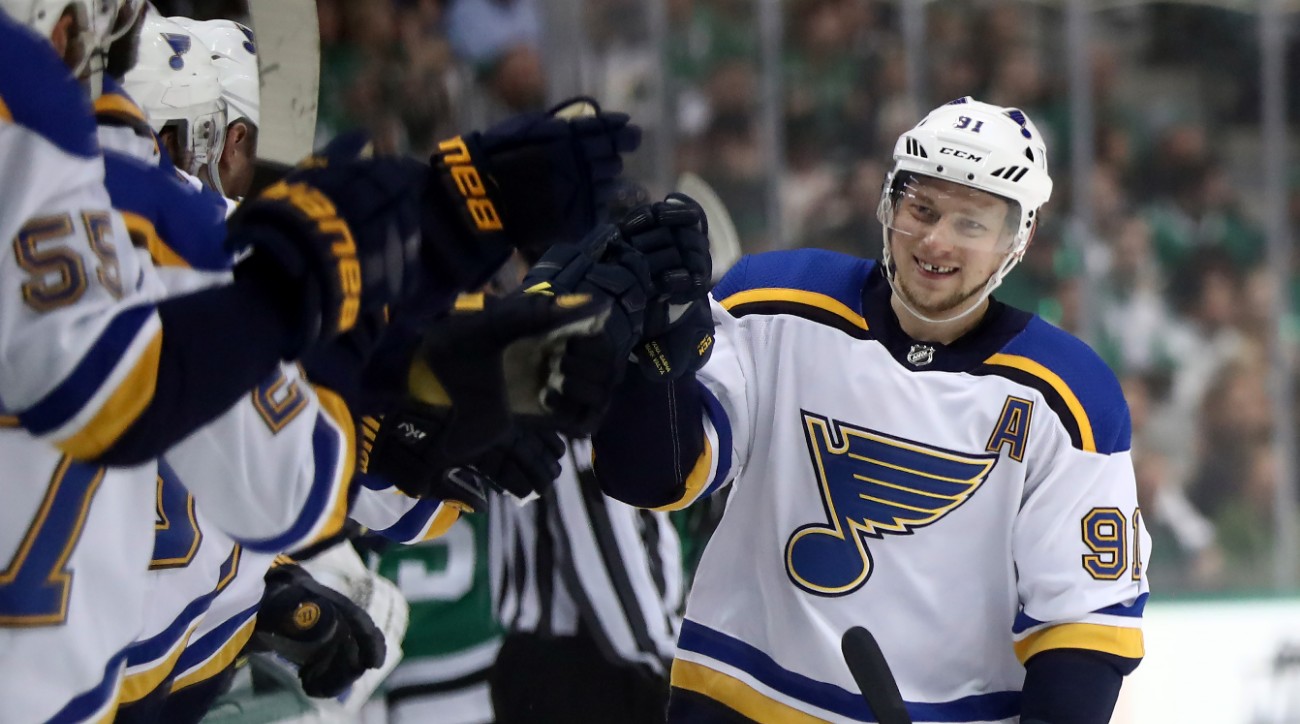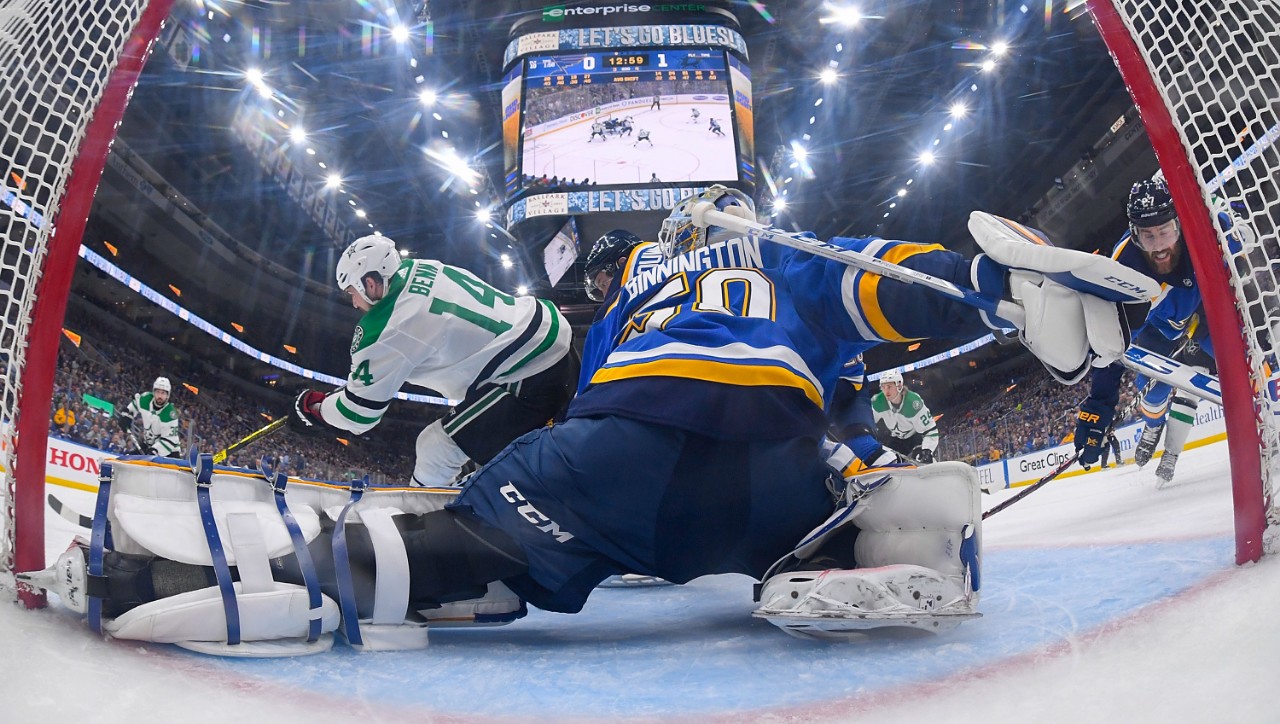After Waiting 52 Years, Can St. Louis Come Back From the Brink?

ST. LOUIS — On Wednesday evening, just a few blocks east down Clark Ave. from the Enterprise Center, St. Louis hosted a guest. The Blues were in Dallas, up 2–1 in the Western Conference semifinals, and in their absence the organization hosted an official watch party at Ballpark Village, the five-year-old entertainment complex next to Busch Stadium. There, the NHL announced, Lord Stanley would take supplicants.
As news trickled out that the Cup was in town and would be stationed among hundreds of die-hard Blues fans during a pivotal game, the reaction was swift. On social media, a mix of horror and existential dread emanated from a fanbase that’s gone its entire 52-year existence without a title: Don’t enter the same room as the Cup, don’t look at it, don’t breathe air that’s interacted with it. From his microphone as he hosted his radio show that evening, former Blue and St. Louis native Cam Janssen seethed. “It’s a sensitive relic that we haven’t [won],” Janssen recalls thinking earlier this week. “Whenever it’s necessary, bring it here. We’ll have a tour. But it’s not necessary yet.”
That’s putting things gently. And as he’s transitioned into his post-retirement media career, the former enforcer who played nine NHL seasons has learned his listeners aren’t particularly interested in glossed-over opinions. So he adds: “Get that damn thing out of St. Louis.”
The Blues would go on to lose that night and again at home on Friday, falling behind to the Stars, three games to two. They’ll play for their lives Sunday afternoon as the city holds out hope that it’ll one day be able to treat the Stanley Cup as anything other than radioactive. Tradition bars players who’ve yet to win a title from touching the silver trophy—for the Blues, only Oskar Sundqvist, who played 20 games for the Penguins in 2015–16, can lay a finger—but in St. Louis that superstition extends to an entire fan base, the totality of a metropolitan area. In the press box before Game 5, whispers circulated that one media personality had gone so far as to kiss it. Kiss it! How many others had taken photos, smiled beside it, dared look at it and hope this might be the year?
But the Blues, who finished the regular season with 99 points, can’t blame skin-to-metal contact for their situation. No, this is merely a product of a flat Game 4 and Dallas goalie Ben Bishop’s near-perfect play, and now the cursed team, the beaten-down fans, must remember that this year, they were supposed to be something else.

Losing in the playoffs is nothing new in St. Louis. Since their first season in 1967–68, the Blues have missed the postseason just nine times. In their first three seasons, they were the expansion wunderkind, playing in the Stanley Cup Finals each spring. They’ve not gotten that far since, and early exits have piled up as superstars have come and gone. Faces of the franchise put in their years and sought Cups elsewhere—often returning to St. Louis in retirement. Brett Hull won his in Dallas, Brendan Shanahan in Detroit, Chris Pronger in Anaheim. Last year, it was T.J. Oshie in Washington, D.C. “Every year, [it seemed like], a guy would win the Cup, and he'd hoist it for the first time, and he'd been a Blue,” Brad Lee, the publisher since 2013 of Game Time, a fan-generated newsletter sold outside Blues home games, says. “It was maddening."
But this season’s team has hardly fit that blueprint. Last summer, St. Louis reloaded in a big way after missing the playoffs, trading for center Ryan O’Reilly and adding Pat Maroon, David Perron, Tyler Bozak, among others, in free agency. They looked on paper like contenders and then played like strangers for three months. Coach Mike Yeo was fired in November, replaced with assistant Craig Berube. On Dec. 10, when the team called up rookie goalie Jordan Binnington from its AHL affiliate in San Antonio, it was 10-14-4; only the Blackhawks and Kings had fewer points in the Western Conference.
By January, Binnington was starting for the Blues, playing like the best goalie in the league—a reputation he sustained throughout the spring. “You can’t evaluate what you have in front of you when you aren’t getting the saves you need,” Janssen says, and with Binnington unflappable in goal, the team was able to take a look at what it was doing poorly and what it had begun to do increasingly well. Right wing Vladimir Tarasenko emerged from the worst start of his career. Colton Parayko began to anchor the defense. And Maroon, a St. Louis native, fell into form after the calendar turned to 2019, scoring seven goals and recording a plus/minus of +11 compared with -14 in October through December. The team, Maroon says, had “found its belief system”—which looked a whole lot like a lanky 25-year-old goalie with a long face and no fear.
Drew Bannister, the first-year coach of the San Antonio Rampage, has known Binnington since the goalie’s junior hockey days. When the two reunited last fall, Bannister noticed a maturity that had grown in concert with Binnington’s steely nerves. He was better able to move on from factors he couldn’t control, the coach says, and he took pressure off defensemen, controlled rebounds like a veteran. “It’s not like they just threw him in and were hoping for some magic potion,” Bannister explains; by the time Binnington landed in St. Louis, Blues brass suspected he might be a jolt—but they underestimated the voltage. With several thousand-times more eyes on him in St. Louis, the goalie did even more, shutting out Philadelphia in his first start. Four weeks into the wild experiment of playing their fifth-string goalie, the Blues had lost in regulation just once in a Binnington start, and on Feb. 4, Maroon’s brother Phil placed a bet on St. Louis to win the Stanley Cup at 40–1 odds. The team had won two in a row but still had the second-fewest points in the conference. His wife told him not to waste their money.
Then the Blues won again and again, 11 consecutive victories. Phil Maroon had been onto something, and as the streak powered St. Louis up the standings, the team adopted an unlikely victory song: the ‘80s platinum hit “Gloria,” its high notes proclaiming the Blues, too, were on a run now. After so many years of consistently good regular-season play reaping playoff heartbreak, maybe this team was onto something new. Maybe the rollercoaster, somehow, was the formula.
“I think during that streak, there were games that Binnington just won by himself,” O’Reilly says. “You’d have those nights where you’d kind of get the bounces. During that, it was just, OK, let’s win the next game, let’s win the next game. When it ended, yeah, it was disappointing… but it was, alright, let’s get back.” And from that experience, O’Reilly says, the team learned a mindset, which it carried into the playoffs as the Western Conference’s No. 3 seed: “We don’t care who we’re going to face,” he explains. “We can beat anyone.”
As the NHL’s postseason field has thinned this spring, few of hockey’s old guard have hung on, and three teams still playing have never won a Stanley Cup. There are the San Jose Sharks, Cup-less and founded in 1991. The Blue Jackets, who played their first game in the first year of this millennium, are similarly without a title. And then there are the Blues, winners of nine division championships and no titles. St. Louis is tied with Toronto for the longest Cup drought—though the Maple Leafs can claim 13 titles, the last of which they won the spring before the first puck dropped here.
The Blues are the Cubs of baseball—except they blew up their Wrigley Field in 1999. The destruction of the St. Louis Arena, a cavernous dome built in 1929 and known for its vertigo-inducing nosebleed seats, checkered roof and unmatched sightlines, is just one of many baffling and eyebrow-raising decisions in Blues history. There’s the year the team, already essentially stripped for parts as its owners tried to pull off a sale that would send it to Saskatoon, simply did not show up for the 1983 draft. Two decades later, another ownership group left fans puzzled and embittered as it spent less and less time and money on hockey operations and more on three futile campaigns to land an NBA franchise. And don’t forget the time the Blues signed Wayne Gretzky in 1996 only to leave him so disgruntled he rejected a three-year deal at the end of the season.
For the last century, St. Louis has been a baseball town, feeding off the Cardinals’ 11 rings. The Blues have been the little sibling down the street, named for the famous W.C. Handy tune and the soulful but lively style of music that flourished in the city in the middle of the 20th century. Eighty-five years younger than the Cardinals, the Blues might be less of an establishment, but they’re entrenched, and they draw reasonably well thanks to a rabid if traumatized fan base. And three years ago, St. Louis realized there might be a sports fate worse than claiming a talented but underachieving hockey franchise: Its perennial loser of an NFL team can bolt to a bigger market, leaving behind a trail of insults and broken promises. That’s what happened when the Rams announced their intent to decamp to Los Angeles—and the two remaining St. Louis teams seized an opportunity from the wreckage. At the first Blues home game after Stan Kroenke’s messy adieu, Blues owner Tom Stillman and Cardinals president Bill DeWitt III, each dressed in a jacket bearing the other team’s logo, dropped a ceremonial first puck. In the months to follow, the teams began to sell co-branded merchandise. More Cardinals began showing up at the Enterprise Center, a trend that strengthened during this playoff run. Yadier Molina toasting the camera with a cold Bud Light and a look of abject joy at a Blues game is just about the loudest way for the city to shoulder its new reality: This is a hockey town, too.
When Janssen made his debut in 2005, he became the first player born and raised in St. Louis to lace up skates in the NHL. What followed was a wave of prospects from the Gateway City, some the sons of retired Blues, others little boys who grew up idolizing the likes of Hull, Al MacInnis, Kelly Chase and Tony Twist. The Blues might never have won a Cup, but they’d been dazzling enough on the ice to inspire a generation of young players. Trent Frederic was the No. 29 pick in 2016. Brady Tkachuk, the son of longtime Blue Keith Tkachuk, went fourth overall to Ottawa in last year’s draft. But even as the St. Louis kids have proliferated around the league, the closest any of them has come to a Cup was in 2012, when Janssen and his Devils teammates watched the Kings hoist the thing.

In Game 5 on Friday night, St. Louis outplayed Dallas in nearly every phase of the game but lost, 2–1. After the game, Stars coach Jim Montgomery gave the Blues a nod as the better team. But, he qualified, Bishop was the best player, which was more than evident each time St. Louis came up empty on a power play. Only one of their 39 shots on goal went in, in the third period, and as the series returns to Dallas, the Blues need to pull off a comeback from the brink.
No matter how invincible the Blues’ rollercoaster of a season has made them feel in moments, Friday stung. This is still a team that knows expectations are meaningless, that what should happen is not necessarily what will. Based on the first half of the season, the Blues shouldn’t be here. Based on history, they should lose this series. But St. Louis got where it is today with a record of 30-10-5 since Jan. 1. It had a stretch from Jan. 12 through March 17 during which it played 22 of 30 games on the road and won 13 times on enemy ice. In the first round of the playoffs, the team won all three of its road games in Winnipeg, and it also took the first game this series in Dallas.
“I don't think we're entering the zone as good as we can,” forward Brayden Schenn said after the game. "It's making it pretty tough on each other. We're kind of putting each other in bad spots. I think execution has got to be way better. As soon as the execution picks up, then the swagger will come, the confidence will come.”
But swagger was absent for much of Friday as Bishop’s play sucked the chilly air out of the Enterprise Center. The place had the energy of a mausoleum and the angst quotient of a middle-school dance before St. Louis got on the board with 11:34 to go in the third period, and for most of the rest of the game, a rational observer—and there are few of those in St. Louis, after all these years of frustration—might have said that it seemed likely that the Blues would tie things up. They dominated possession of the puck, got a power play on a hooking call on Jamie Benn, and still, nothing. With 4:15 to go, Sundqvist had the team’s best chance yet to eke out a goal; Bishop lay splayed on the ice, and the center’s shot hit the goalie’s leg. “Gloria” hasn’t played since Monday.
St. Louis rock ‘n’ roll legend Chuck Berry must roll in his grave each time the dance-club hit plays to celebrate the team named for the timeless music he helped popularize. The blues bestowed St. Louis one of the most interesting names in hockey and some of the best uniforms. But for the past 52 years, piano tunes and ragtime haven’t worked. This season, St. Louis needed a banger, and it still hopes to play it 10 more times.
